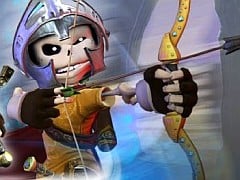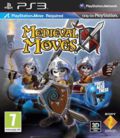You can trust VideoGamer. Our team of gaming experts spend hours testing and reviewing the latest games, to ensure you're reading the most comprehensive guide possible. Rest assured, all imagery and advice is unique and original. Check out how we test and review games here
Do you remember Sports Champions? The PlayStation Move launch title let you play a number of different sports by using one, or ideally two, Move controllers – one for each hand. Duelling, archery and disc golf were among the best sports on offer, and it’s these that have formed the base of gameplay in Medieval Moves.
You play Edmund, a young boy who must recover a stolen amulet from the evil Morgrimm – a kind of Skeletor lookalike. With the amulet gone Edmund becomes an undead skeleton, and must fight through waves of enemy skeletons and sub-bosses (who each have a piece of the amulet) in order to finally take on the big bad guy. Whereas Sports Champions appealed to everyone, Medieval Moves is one for the kiddies.
The game can be played using a single Move controller, but it’s best when you have a wand in each hand. Duelling with a sword and shield is the key gameplay component, handled just as it is in Sports Champions. The left wand is your shield, able to be moved around to block incoming projectile and melee attacks, while the right wand is your sword, slashable in real-time from any direction.
As well as swordplay Medieval Moves includes projectile weapons. A bow and arrow can be used in a way similar to how you’d imagine using one in real life. Move the right wand controller behind your back to pick an arrow, then move the bow and arrow together before pulling the arrow back and releasing when you’ve got a target in your sights.
Ninja stars, on the other hand, are based on the disc golf seen in Sports Champions, with your aim and strength determined by your flick with the right Move wand. It’s just like you’re throwing a Frisbee. Additional moves and abilities open up as you progress, but these are the core combat mechanics you’ll be using along the adventure.
In the heat of combat you’ll often be able to make use of all of these, block and countering close enemies, taking out distant ones using your bow and stopping charging foes with a few quickly thrown ninja darts.
All of this works very well, with the Move wands able to deliver controls that we haven’t seen very often in motion-controlled titles. That said, Medieval Moves is entirely on rails, meaning you have no say over your character’s movement through each level other than picking a route when you’re offered a choice. As good as the combat feels, the game is pulled down to a very casual experience due to the way you’re ferried through the environments.
Medieval Moves is also an incredibly repetitive and tedious experience once the initial excitement over the combat controls fades – not to mention a tiring one on your arms. Hacking and slashing enemies over and over again soon takes its toll on your body, but it’s the bow and arrow technique that caused me most pain. The motion required to load an arrow and then shoot it isn’t an everyday action, and as such the frequency of use in the game resulted in some niggling arm ache.
While the game is on-rails, you do get the odd moment in which you can interact with the environment. You’ll have to aim a grappling hook at sign-posted targets in order to leap to reach new areas, and QTE-like moments ask you to move the controllers to match on-screen arrows.
With the on-rails gameplay you’d have thought the developer could have gone to town on the game’s visuals, but sadly what we have here is a bit of a letdown. There’s a certain childish charm to the character designs and the comic book-style cutscenes, but the environments lack creative spark. With the mixture of dark caves, industrial areas and more lush outdoor settings, there’s a slight Fable-twang to the game’s presentation, but the overall appearance is significantly worse than Lionhead’s title.
On top of the single-player adventure a couple of extra mini-games have been included, which can be played alone or with/versus a friend. Sadly none of these are standard duelling (you’ll have to stick to Sports Champions for that), instead giving you waves of enemies to defeat. I’d had enough of the combat in the main campaign, so the extra modes did little for me. If you’re into them they can be played split-screen or online.
Kids will no doubt be able to tolerate some of the game’s crippling repetition and focus more on the coolness associated with the Move controls, but that doesn’t give these flaws a free pass. Functionally the combat works, but encounters are too simple and the on-rails movement gives the title a definite casual gaming feel. Outside of the first-person shooters designed to work with Move, this is one of the better non-mini-game collections, but things start to become increasingly less interesting the farther you progress.

/https://oimg.videogamer.com/images/b553/medieval_moves_4.jpg)






